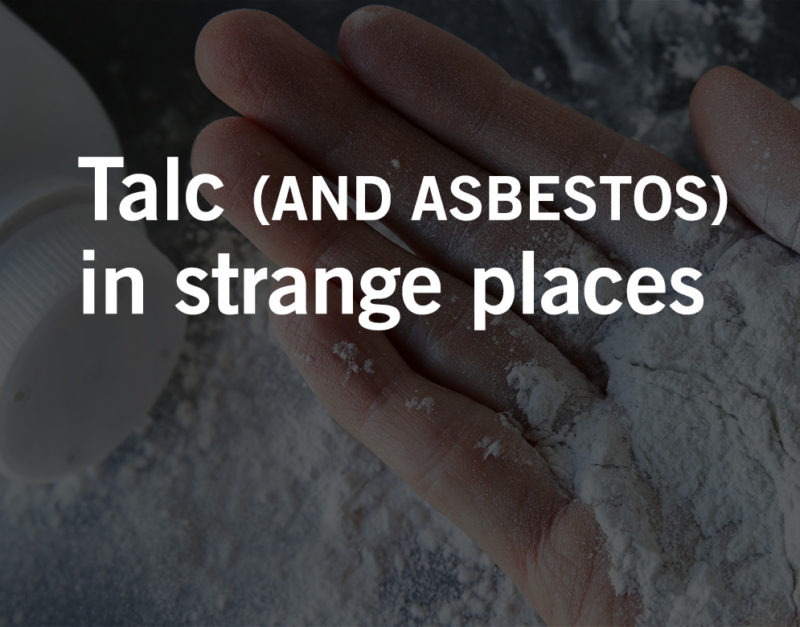 April 27, 2021
April 27, 2021 For decades, women and researchers have claimed a link between ovarian cancer and talc in Johnson & Johnson Baby Powder and other products. Talcum powder can carry traces of asbestos, a known carcinogen.
But manufacturers continue to use talc in many powder-based products, even though asbestos contamination is possible, and asbestos has been linked to many cancers and most cases of mesothelioma. Additionally, investigations show the U.S. Food and Drug Administration downplayed concerns about talc raised by independent experts since the 1970s in deference to manufacturer claims of talc’s safety.
What is talc?
Talc is a naturally occurring mineral mined from clay deposits. It is the softest mineral known. It is used in a variety of products as a solid lubricant, moisture absorber, and for heat resistance. It may be listed in ingredients as talc, talcum powder, or magnesium silicate.
How is talc connected with asbestos?
Asbestos is also naturally occurring. Asbestos and talc are often found in close proximity, making cross-contamination possible during mining and processing. Manufacturers of cosmetic and personal care products voluntarily agreed to ban asbestos from their products. Still, there is no enforcement mechanism within the Personal Care Products Council, the industry trade association. The FDA does not require cosmetics and ingredients to be tested before they are approved for sale.
Which products contain talc?
Because talc is a readily available and long-used ingredient for improving the feel and performance of consumer goods, it can be found in some of our most common products.
- Cosmetics. Many powder cosmetics, lipsticks, and mascaras contain talc because it makes the product feel smoother and wear longer. Because talc also has a pearly appearance, adding talc to powder makeup can give an alluring sparkle. Cosmetic products that use talc have been found to contain small amounts of asbestos. In recent years, asbestos has been found in makeup products sold at accessories retailer Claire’s, clothing store Justice, and online retailer Amazon. Revlon has recently been named in a lawsuit regarding their Jean Nate talcum powder.
- Food and medications. The human body doesn’t digest talc, but it is used in food as a carrier for food coloring, to keep baked goods and other foods from sticking, and even to improve the appearance of white rice and the texture of chewing gum. In medications, talc is used as an anti-caking agent.
- Children’s toys. The U.S. Public Interest Research Group (U.S. PIRG) Education Fund reported that Playskool crayons sold at Dollar Tree and other retailers tested positive for asbestos. Crayon manufacturers use talc as a binder in the wax. Three years prior, the Environmental Working Group Action Fund found four brands of crayons made in China contained asbestos fibers. Additionally, asbestos fibers were found in children’s fingerprinting and detective kits sold at toy stores. U.S. laws do regulate the amount of asbestos in drinking water and schools. Still, according to Kara Cook-Schultz, toxics director for U.S. PIRG, there are no regulations on the amount of asbestos allowed in children’s products.
- Ceramics and tiles. Talc is used in the production of a wide range of ceramic products, including tableware, roofing and flooring tiles, natural stone countertops, and bathroom appliances. Talc improves thermal shock resistance allowing ceramic products to withstand sudden changes in temperature without cracking or breaking.
- Industrial goods. The same lubricating and heat-resisting properties that make talc popular in consumer products ensure that it is also useful in industrial applications. Talc is used as a lubricant to keep metal parts from rubbing and wearing, as a coating in inner tubes and rubber gloves to prevent sticking, and a whitening agent in paints. It also resists acid, making it useful as a component of laboratory tables.
After 50 years, the FDA is finally starting to pay attention to the evidence that asbestos contamination in talc is a serious issue. After asbestos was found in various products, including a batch of Johnson & Johnson Baby Powder, the regulatory body decided to hold public hearings on testing for asbestos contamination in cosmetic and personal care products. Johnson & Johnson voluntarily recalled that batch of Baby Powder and has since announced they will no longer sell talcum powder in North America. However, they maintain that the positive results were wrong, and there is no danger in using their talc-based products. However, internal documents discuss Johnson & Johnson’s longtime knowledge that cancer-causing asbestos could be found in their Baby Powder. As of March 2020, Johnson & Johnson was facing more than 19,000 lawsuits related to talcum powder.
In addition to the link between asbestos-contaminated talc and ovarian cancer, talc has been implicated in recent cases of mesothelioma, broadening the group at risk beyond occupational exposure.
Companies have a responsibility to the public to manufacture safe products with reasonable warning labels. If they fail to do this and people are injured, the manufacturers and distributors must be held accountable.
How We Help Victims of Asbestos Exposure
Seek justice with the help of our experienced asbestos attorneys. At Waters Kraus Paul & Siegel, our Louisiana asbestos attorneys have held huge corporations responsible for asbestos exposure for decades. We’re ready to work one-on-one with you to understand your mesothelioma case and find justice. If you or a loved one were exposed to asbestos or suffer from a disease caused by asbestos like mesothelioma, we can help.



